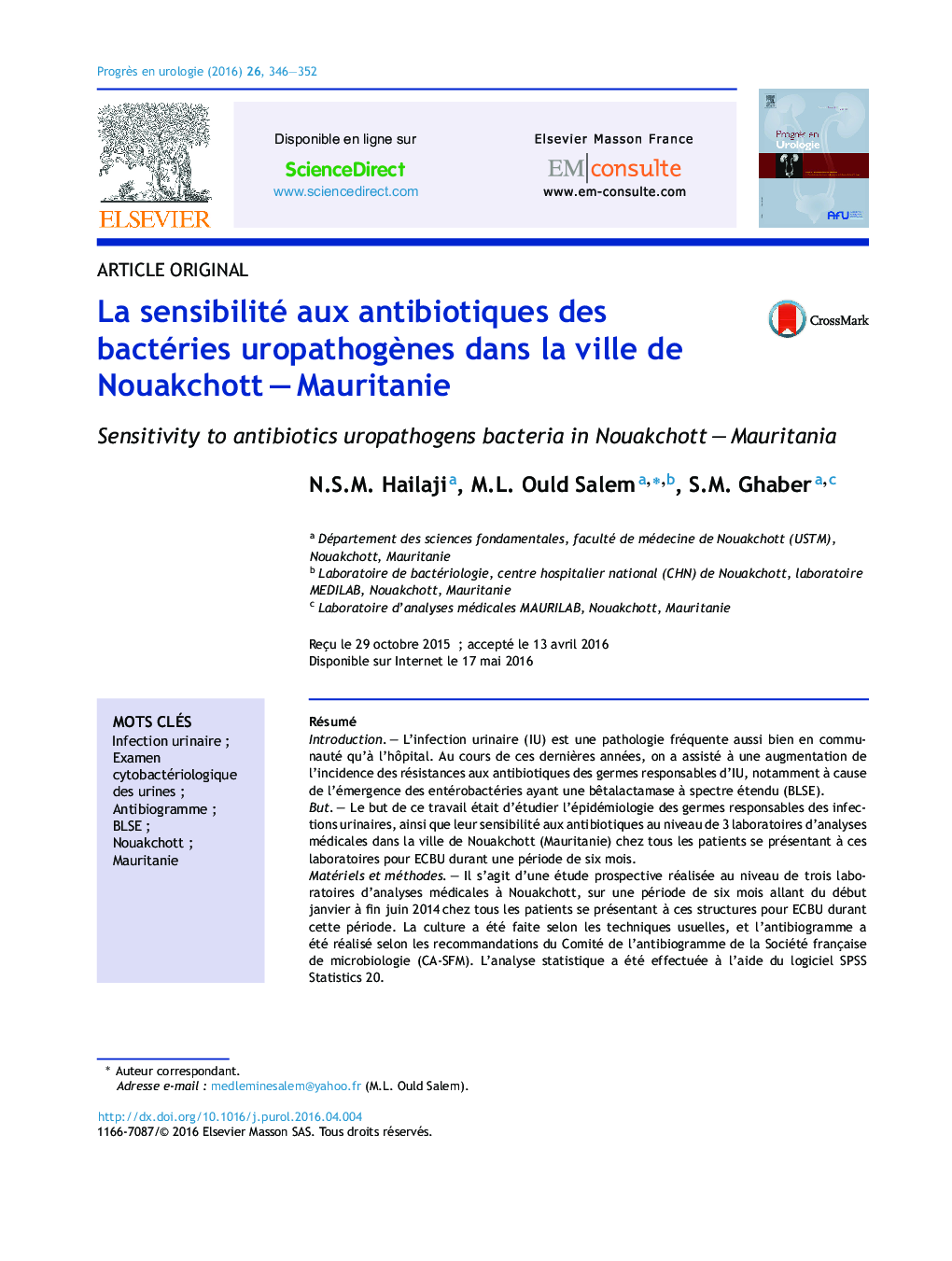| کد مقاله | کد نشریه | سال انتشار | مقاله انگلیسی | نسخه تمام متن |
|---|---|---|---|---|
| 3823588 | 1246712 | 2016 | 7 صفحه PDF | دانلود رایگان |

RésuméIntroductionL’infection urinaire (IU) est une pathologie fréquente aussi bien en communauté qu’à l’hôpital. Au cours de ces dernières années, on a assisté à une augmentation de l’incidence des résistances aux antibiotiques des germes responsables d’IU, notamment à cause de l’émergence des entérobactéries ayant une bêtalactamase à spectre étendu (BLSE).ButLe but de ce travail était d’étudier l’épidémiologie des germes responsables des infections urinaires, ainsi que leur sensibilité aux antibiotiques au niveau de 3 laboratoires d’analyses médicales dans la ville de Nouakchott (Mauritanie) chez tous les patients se présentant à ces laboratoires pour ECBU durant une période de six mois.Matériels et méthodesIl s’agit d’une étude prospective réalisée au niveau de trois laboratoires d’analyses médicales à Nouakchott, sur une période de six mois allant du début janvier à fin juin 2014 chez tous les patients se présentant à ces structures pour ECBU durant cette période. La culture a été faite selon les techniques usuelles, et l’antibiogramme a été réalisé selon les recommandations du Comité de l’antibiogramme de la Société française de microbiologie (CA-SFM). L’analyse statistique a été effectuée à l’aide du logiciel SPSS Statistics 20.RésultatsSur 3082 prélèvements d’urine, 568 répondaient aux critères d’infection urinaire, soit 18,4 % de positivité. Ces infections ont concerné des patients hospitalisés (17,8 %) et surtout des consultants externes (82,2 %). Le sex-ratio F/H était 1,6. L’épidémiologie des infections urinaires au niveau de ces 3 laboratoires d’analyses médicales est globalement comparable aux données de la littérature en ce qui concerne l’âge, le sexe, le terrain, et le germe le plus fréquemment responsable (Escherichia coli 64,4 %). Mais, des différences sur les résistances sont observées : résistances plus élevées aux bêtalactamines, aux quinolones de 1re génération, aux fluoroquinolones et au cotrimoxazole. L’IU était fréquente chez les patients sondés (64,9 %), les diabétiques (52,4 %), les hospitalisés (49,3 %), et chez les femmes enceintes (38,7 %). La prévalence des infections urinaires à entérobactéries productrices des BLSE dans notre étude était de 12,8 %, parmi toutes les infections urinaires à entérobactéries. Les souches d’E. coli et de Klebsiella spp isolées ont exprimé une BLSE respectivement dans 10,4 et 20,4 % des cas.ConclusionLa répartition des souches dans notre étude est comparable à la littérature, en revanche, la résistance aux antibiotiques est plus importante dans notre série, conséquence probablement de l’usage inapproprié de ces molécules dans notre pays, d’où l’intérêt de prévoir une bonne stratégie d’approvisionnement et de dispensation de ces molécules ainsi que la révision du traitement empirique des IU dans notre pays.Niveau de preuve4.
SummaryIntroductionA urinary tract infection (UTI) is a frequent pathology in outpatients and admitted patients as well. In recent years, there has been an increase in the resistance of germs responsible for UTI to tested antibiotics, particularly because of the emergence of Enterobacteria secreting extended-spectrum beta-lactamase (ESBL).ObjectiveThe aim of this work was to study the epidemiology of germs responsible for urinary tract infections and their antibiotic sensitivity at three clinical laboratories in the city of Nouakchott (Mauritania) in all patients presenting to these laboratories for urine culture during a period of six months.MethodsThis is a prospective study conducted at three clinical laboratories in Nouakchott, over a period of six months from January 1st to June 30th 2014 for all patients coming to these laboratories for urinalysis test during this period. The culture was performed according to the usual techniques, and the antibiogram was done according to the recommendations of the Antibiogram Committee of the French Society of Microbiology. The statistical analysis was performed using SPSS Statistics 20.ResultsFrom 3082 urine exam, 568 were positive, which means 18.4%. These infections were for hospitalized patients (17.8%) and outpatients in particular (82.2%). Sex ratio F/M was 1.6. The epidemiology of urinary tract infections in these three medical analysis laboratories is comparable to the past studies data regarding age, sex, and the bacteria, the most frequently responsible (Escherichia coli 64.4%). But differences in the resistance of E. coli are observed: higher resistance to beta-lactam antibiotics, the quinolones, the fluoroquinolones, and cotrimoxazol. UTI was common in patients with urinary catheter (64.9%), diabetics (52.4%), hospitalized patients (49.3%) and pregnant women (38.7%). The prevalence of urinary tract infections caused by Enterobacteria ESBL in our study was 12.8%, of all urinary tract infections caused by Enterobacteria; 10.4 and 20.4% of the E. coli and Klebsiella spp, respectively produced a ESBL.ConclusionThe distribution of germs in our study is comparable to the literature, however, antibiotic resistance is higher in our study, which is probably a result of the inappropriate use of these drugs in our country, therefore it is important for us to create a good strategy to supply and distribute these drugs, as well as the review of the empirical treatment of UTI in our country.Level of evidence4.
Journal: Progrès en Urologie - Volume 26, Issue 6, May 2016, Pages 346–352